Geoscience Reference
In-Depth Information
of the mountain in a Pratt-type model. This is because the
mass de
ciency comprising the root zone partly balances
the gravitational consequences of the mass excess repre-
sented by positive topography. If there is no local compen-
sation, then obviously the gravitational effects of the
terrain alone affect the reading. The isostasy-related
changes in gravity tend to be of suf
ciently long wave-
length that they appear as a constant component in most
exploration-related gravity surveys. They can be compen-
sated using an isostatic correction (Lowrie,
2007
), import-
ant for very large regional surveys, but not normally
required for smaller mineral exploration-scale surveys.
a)
Height due to
ground clearance
(
h
clr
)
Height due to
topography (
h
top
)
Datum level
b)
B
Gravity meter
A
Height due to
topography (
h
top
)
A
Slab
Datum level
3.4.5.1
Free-air correction
If a measurement of gravity were made on
at ground and
then, at the same location, the measurement repeated at
the top of a tall step ladder, the value of observed gravity
would be less at the top of the ladder owing only to the
increase in distance between the measurement location
and the Earth
c)
Datum level
s centre of mass, cf. the 1/r
2
component of
Eq. (3.3)
. The change in gravity with height is compensated
with the free-air correction (g
FA
) given by:
'
Figure 3.16
(a) The relationship between instrument height,
topography and the datum level for the free-air correction. (b) The
concept of the Bouguer slab. The signi
cance of the various hatched
areas is described in the text. (c) Representation of topographic
variation (in 2D) by a series of
2G
R
h
g
FA
¼
ð
3
:
15
Þ
flat-topped prisms. Note the smaller
size of the prims close to the gravity station.
where h is the height (m) of the gravity station above the
datum (usually the geoid), R is the average radius (m) of
the Earth (6371 km) and G the universal gravitational
constant given in
Section 3.2.1.1
.
This reduces to:
level, usually the geoid (sea level), so they can be combined
into a single elevation correction. When the gravity meter is
elevated above the topography (
Fig. 3.16a
), e.g. on a tripod
or in an aircraft, it is not possible to apply a single height-
dependent elevation correction. Usually the three correc-
tions are applied separately and in the sequence described
below.
A common misconception regarding these corrections is
that their application produces the equivalent reading that
would have been obtained if the gravity meter had been
located at the datum level. This is not the case, since such a
for height and topographic effects whilst retaining relative
changes due to lateral density changes in the subsurface.
Another in
uence related to topography is the isostatic
state of the survey area, in particular whether local or
regional isostatic compensation occurs (Lowrie,
2007
).
For example, the mass deficit of a mountain
g
FA
¼
3
:
086h gu
ð
3
:
16
Þ
which is simply the free-air gradient multiplied by the
height. Station height needs to be measured with an accur-
acy of about 3 cm in order to calculate the free-air correc-
tion to an accuracy of 0.1 gu. The free-air correction
compensates for height variations of the gravity meter
above or below the datum level, where the station height
is that of the topography (h
top
) plus the height above the
free-air correction is added to the gravity reading, noting
that height is negative for stations below the datum level so
the free-air correction is then negative.
3.4.5.2
Bouguer correction
The free-air correction only accounts for the difference in
height between the instrument and the datum level. When
the height variation is caused by topographic variations, as
is usually the case, the intervening mass of a hill above the
s root in local
Airy-type compensation leads to lower gravity than a set-
ting where the flexural rigidity is sufficient to carry the load
'





























































































































































































































Search WWH ::

Custom Search